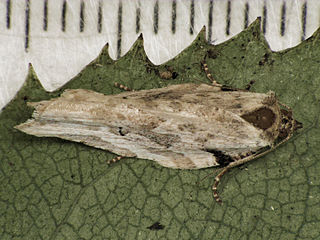
Copromorphidae, the "tropical fruitworm moths", is a family of insects in the lepidopteran order. These moths have broad, rounded forewings, and well-camouflaged scale patterns. Unlike Carposinidae the mouthparts include "labial palps" with the second rather than third segment the longest. With other unusual structural characteristics of the caterpillar and adult, it could represent the sister lineage of all other extant members of this superfamily. The genus Sisyroxena from Madagascar is also notable for its unusual venation and wing scale sockets.

Metacrias is a genus of moths in the family Erebidae. All species are endemic to New Zealand.

Asaphodes is a genus of moths in the family Geometridae erected by Edward Meyrick in 1885. This genus is endemic to New Zealand and species within this genus are found throughout New Zealand including the North, South and Stewart / Rakiura Islands.

Austrocidaria is a genus of moths in the family Geometridae. It was described by John S. Dugdale in 1971.

Pseudocoremia is a genus of moths in the family Geometridae erected by Arthur Gardiner Butler in 1877. This genus is endemic to New Zealand.

Archyala is a genus of moths belonging to the family Tineidae. This genus is endemic to New Zealand. Archyala was first described by Edward Meyrick in 1889.

Epalxiphora is a genus of moths belonging to the subfamily Tortricinae of the family Tortricidae. This genus was first described by Edward Meyrick in 1881 and is endemic to New Zealand.

Zealandopterix zonodoxa is a moth of the family Micropterigidae. It is endemic to New Zealand and is located from Hawkes Bay north as well as on Poor Knights, Little Barrier and the Great Barrier Islands. It is the smallest micropterigid in New Zealand and the shiny white markings on the forewing of this species display variation. It is a moth that is active during the day, but has been collected using UV light. Adults are on the wing from September to March and the species has been witnessed visiting the flowers of Nīkau and Cordyline pumilio in large numbers. It inhabits a wide variety of moist indigenous forest but is associated with forests in which podocarps are common. Larvae have been sieved from rotten wood on the floor of a mixed podocarp/broadleaf forest or extracted from moss or from bryophytes.

Izatha is a genus of moths of the family Oecophoridae. They are commonly known as lichen tuft moths. This genus is endemic to New Zealand.

Morosaphycita oculiferella is a moth of the family Pyralidae described by Edward Meyrick in 1879. It is known from Australia and New Zealand.

Pyroderces aellotricha, also known as the Cosmet moth, is a moth of the family Cosmopterigidae. It is found in New Zealand, in Australia and the Cook Islands.

Pyrgotis plagiatana is a species of moth of the family Tortricidae. It is found in New Zealand.

Pyrgotis zygiana is a species of moth of the family Tortricidae. It is endemic to New Zealand.

Eutorna is a genus of gelechioid moths.

Aponotoreas orphnaea is a moth of the family Geometridae. It is endemic to New Zealand.

Atomotricha is a genus of moths of the family Oecophoridae. The species in this genus are endemic to New Zealand.

Cateristis eustyla is a species of moth in the family Tineidae. This species is found in New Zealand and Tasmania. It is classified as "Data Deficient" by the Department of Conservation.

Austrocidaria anguligera is a species of moth in the family Geometridae. It is endemic to New Zealand. It is regarded as being uncommon but is frequently confused with Austrocidaria bipartita.

Proteodes is a genus of moths in the family Depressariidae. It was first described by Edward Meyrick in 1883. This genus is endemic to New Zealand.




















